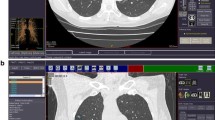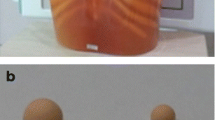Abstract
Purpose
The aim of this study was to determine whether postprocessing techniques could improve the accuracy of detecting lung nodules.
Materials and methods
A total of 154 segmented lung volumes of multidetector-row computed tomography (MDCT) data were the subject of the study. Lung nodules were present in 88 volumes and absent in 66 volumes. We prepared four groups: (1) 7- or 10-mm thick-section axial images; (2) 1-mm thin-section axial images; (3) sliding slab maximum intensity projection (MIP) images with a slab thickness of 15 mm; and (4) sliding slab volume rendering (VR) images with a slab thickness of 15 mm. Sixteen physicians reviewed each group in interactive cine mode. The observers’ performance in the detection of lung nodule was evaluated by receiver operating characteristic (ROC) analysis.
Results
The observers’ performance of the MIP and VR groups was significantly better than in other two groups. There was no significant difference statistically between the thin and thick groups.
Conclusion
The detectability of lung nodules is improved with the use of sliding slab MIP and VR using thin-section image data. Thin-section volume data are essential for improving diagnostic accuracy, but observation of thin-section images without utilization of image-processing techniques dose not improve diagnostic accuracy.
Similar content being viewed by others

References
DV Paranjpe CJ Bergin (1994) ArticleTitleSpiral CT of the lungs: optimal technique and resolution compared with conventional CT AJR Am J Roentgenol 162 561–7 Occurrence Handle8109496 Occurrence Handle1:STN:280:ByuC2M3ls1U%3D
JF Gruden S Ouanounous S Tiggers et al. (2002) ArticleTitleIncremental benefit of maximum-intensity-projection images on observer detection of small pulmonary nodules revealed by multidetector CT AJR Am J Roentgenol 179 149–57 Occurrence Handle12076925
SE Selter PF Judy DF Adams et al. (1995) ArticleTitleSpiral CT of the chest: comparison of cine and film-based viewing Radiology 197 73–8
M Tillich F Kammerhuber P Reittner et al. (1997) ArticleTitleDetection of pulmonary nodules with helical CT: comparison of cine and film-based viewing AJR Am J Roentgenol 169 1611–4 Occurrence Handle9393175 Occurrence Handle1:STN:280:DyaK1c%2FlsVyrtw%3D%3D
FV Coakley MD Cohen MS Johnson et al. (1998) ArticleTitleMaximum intensity projection images in the detection of simulated pulmonary nodules by spiral CT Br J Radiol 71 135–40 Occurrence Handle9579176 Occurrence Handle1:STN:280:DyaK1c3ktVeguw%3D%3D
Author information
Authors and Affiliations
Corresponding author
Additional information
This article was presented at the 2005 Japan Radiological Society annual meeting
About this article
Cite this article
Yoneda, K., Ueno, J., Nishihara, S. et al. Postprocessing technique with MDCT data improves the accuracy of the detection of lung nodules. Radiat Med 25, 511–515 (2007). https://doi.org/10.1007/s11604-007-0176-9
Received:
Accepted:
Published:
Issue Date:
DOI: https://doi.org/10.1007/s11604-007-0176-9



